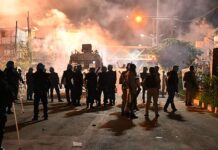Despite controversies and staggering losses, the government is showing no signs of moving away from private rental power plants.
Instead, it has extended the contracts of 10 rental and quick rental power plants by three to five years.
Bangladesh’s power plants now have a combined capacity of about 10,000 MW. The rental power plants deliver 20 percent of this, but are paid over half of the total cost of power production.
Power Development Board says since its increased dependence on the rental plants its losses in four fiscal years stood at about Tk 170 billion, which was covered by subsidies.
The amount equals almost three-fourths of the estimated costs of the Padma bridge project.
Retail and bulk power prices have been hiked seven times in the last five years to adjust with these high costs.
The government is yet to make a clear statement about how long this situation would continue.
Prime Minister’s Adviser on Power, Energy and Mineral Resources Tawfiq-E-Elahi Chowdhury told bdnews24.com, “Our master plan includes some liquid fuel-based plants. Rentals are already on our country’s soil.”
“Theoretically if we can buy cheap electricity from the rentals with reduced capital costs, there is no sense in approving new plants to buy electricity at high cost.”
A government committee formed to decide on the rental power plants recommended that the plants be continued until 2020.


Finance Minister AMA Muhith said he believed there was no reason to continue operating the plants after 2018-19. The incumbent government’s term ends in 2019.
The Consumers Association of Bangladesh (CAB) adviser Shamsul Alam told bdnews24.com the situation was quite sensitive. “On one hand we’re giving tens of billions in subsidy and on the other, power prices are going up. Even then we cannot meet the demand.”
Alam believed moving to oil-based power production would push the costs even higher, and the public would be the ones to foot the bill.
Government figures say the power production capacity has increased by 5,000 MW to 10,000 MW in the last five years. Over 70 percent of this power is produced from gas but the shortage of the raw material means there is no scope of raising the output.
Less than three percent of power output comes from coal. The government under its master plan intends to increase coal use and reach 34,000 MW capacity, but has not reached a decision on coal extraction.
During the last caretaker government’s regime, 13 rental and quick rental power plants were approved as a temporary measure to meet power demands. The Awami League’s last government approved another 20.
But the quick production came with high capital costs, and the use of diesel and furnace oil as fuel only added to the burden.
According to a PDB financial report, in the last four financial years it has made 20 percent of its electricity purchases from rental plants. This has cost the PDB 42 percent of its total payments for electricity.
The PDB bought electricity from state-owned and private plants for an average price of Tk 4.52 per kilowatt-hour in the same period. Electricity from rental power plants cost Tk 9.50 per kilowatt-hour.
M Tamim, former special assistant for energy to the caretaker government’s chief adviser, said the subsidies had gone up because of the rental power plants.
He told bdnews24.com the PDB’s subsidies had never exceeded Tk 10 billion before the rental power plants were introduced.
“We could have built almost the entire Padma bridge with the subsidies given to the PDB in the last four years. Although, what we must look for here is which spending would make bigger contributions to the GDP. But I think returns from power subsidies should have been higher,” he said.
The government plans to cover the costs of Padma bridge, estimated at $ 2.91 billion, from its own funds.
A study by the government-run Bangladesh Institute of Development Studies estimated that the contribution of quick rental power plants to the GDP growth was 0.8 percentage points.
Tawfiq-E-Elahi defended the subsidies, saying, “I believe this is a social cost. People are getting the benefits of power, industries are benefitting.”
“Power prices depend on the fuel. At present the gas fields cannot supply the kind of gas that we need. The high prices would not have changed if we were to give out long-term contracts for diesel or furnace oil-based plants,” he explained.
The prime minister’s adviser said under the master plan leading up to 2030, deals had been signed for nuclear power and state-owned and private coal-based plants were being built.


“This takes time and money. We need to bring in and store coal and use a lot of land. Again if we want to use our own coal it will take about seven to eight years. That’s why we extended the contracts for the rental plants.”
Tamim, however, thinks the government, which leaned towards rental plants as a short-term solution, did not make any mid-term plans. He believed there were problems in the coal policy as well.
“We’re not going for local coal, and the issue of import is unclear as well,” he said.
Last year, the government signed a deal with Russia for a 2,000 MW nuclear power plant in Rooppur, Pabna, with an estimated cost of $ 3-4 billion.
Foundations have been laid in Rampal, Bagerhat for an imported coal-based plant in joint venture with India. A private 3,500 MW coal-based plant has also been approved.
CAB adviser Alam said oil dependency must be reduced if the costs of power were to be brought down. “We have to raise output anyhow, whether by extracting coal or importing.”
Since 2009 when the Awami League came to power, 58 power plants with a total capacity of 4,483 MW have gone into production.
India is exporting 500 MW. Another 31 plants with 6,000 MW capacity are under construction.
Source: bdnews24










